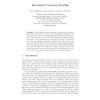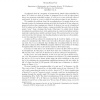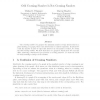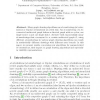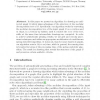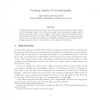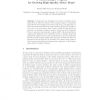103
click to vote
GD
2005
Springer
15 years 6 months ago
2005
Springer
We present a reduction method that reduces a graph to a smaller core graph which behaves invariant with respect to planarity measures like crossing number, skewness, and thickness....
102
click to vote
GD
2005
Springer
15 years 6 months ago
2005
Springer
Most diagram editors and graph construction tools provide some form of automatic connector routing, typically providing orthogonal or poly-line connectors. Usually the editor provi...
GD
2005
Springer
15 years 6 months ago
2005
Springer
120
click to vote
GD
2005
Springer
15 years 6 months ago
2005
Springer
The crossing number of a graph is the minimum number of edge intersections in a plane drawing of a graph, where each intersection is counted separately. If instead we count the nu...
GD
2005
Springer
15 years 6 months ago
2005
Springer
Abstract. Many graph drawing algorithms use st-numberings (st-orientations or bipolar orientations) as a first step. An st-numbering of a biconnected undirected graph defines a d...
107
click to vote
GD
2005
Springer
15 years 6 months ago
2005
Springer
Abstract. In this paper we present an algorithm for drawing an undirected graph G which takes advantage of the structure of the modular decomposition tree of G. Specifically, our ...
GD
2005
Springer
15 years 6 months ago
2005
Springer
115
click to vote
GD
2005
Springer
15 years 6 months ago
2005
Springer
In this paper we investigate the problem of drawing metro maps which is defined as follows. Given a planar graph G of maximum degree 8 with its embedding and vertex locations (e.g...
105
click to vote
GD
2005
Springer
15 years 6 months ago
2005
Springer
Widely varying node degrees occur in software dependency graphs, hyperlink structures, social networks, and many other real-world graphs. Finding dense subgraphs in such graphs is ...
GD
2005
Springer
15 years 6 months ago
2005
Springer

